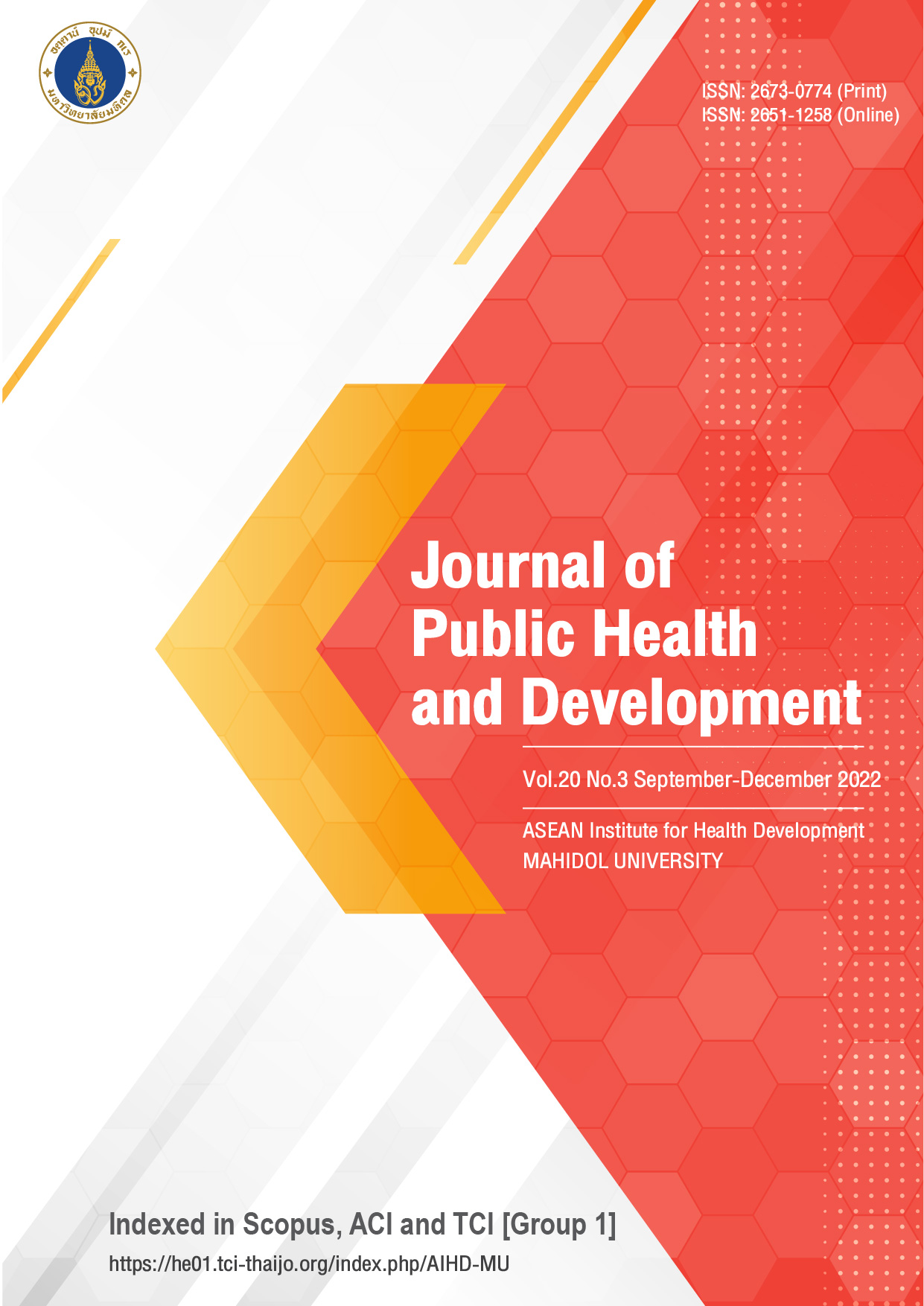Effect of the oral health care program (FUNDEE) on the oral health care behavior status of elderly ethnic groups living in rural areas: a quasi-experimental study 10.55131/jphd/2022/200306
Main Article Content
Abstract
The oral health of elderly people plays a major role in their overall health and quality of life and is an integral part of personal care. The aim of this study was to evaluate the effect of implementing the oral health care program on the oral health status of elderly people living in rural areas. This quasi-experimental study was carried out using a pretest-posttest design on 60 elderly people (30 in the intervention group and 30 in the control group) residing in two randomly selected rural areas of lower-northern Thailand. In the intervention group, the “FUNDEE” model was applied to Hmong elderly people for 12 weeks. The control group received routine care. Using the oral health care behavior assessment tool, the oral health behavior status of elderly people was assessed in both groups on two occasions: a pretest at the onset of the study, and the 12th week after the start of the study. The oral health behavior status of the elderly people in both groups was not statistically significantly different at the baseline, but it changed significantly at the 12th week (p<0.01). The implementation of the “FUNDEE” model for elderly people residing in rural areas may improve their oral health status after 12 weeks. It is recommended that the “FUNDEE” model be included in the care plans of all rural areas to improve the elderly people’s oral health behavior status.
Article Details

This work is licensed under a Creative Commons Attribution-NonCommercial-NoDerivatives 4.0 International License.
References
United Nations. World Population Prospect. [Internet]. [cited 2017 Mar 16] Available from: http://esa.un.org/ unpd/wpp/.
United Nations. Global indicator framework for the Sustainable Development Goals and targets of the 2030 Agenda for Sustainable Development. [Internet]. [cited 2018 Mar 23]. Available from: https:// unstats.un.org/sdgs/indicators/indicators-list/.
The national strategic plan on antimicrobial resistance 2017-2021 Thailand. [Internet]. 2016 [cited 2017 Dec 10]. Available from: http:// narst.dmsc.moph.go.th/documentation/AMR%20strategy%202560-2564.
Foundation of Gerontology Research and Development Institute and Institute for Population and Social Research. Situation of the Thai Elderly 2016. Bangkok: Printery Co., Ltd; 2017.
The Bureau of Dental Health, Department of Health. Thai Dental Public Health Guideline for the Fiscal Year 2020. Bangkok, FL: The Bureau of Dental Health, Department of Health, Ministry of Public Health. 2019. P.39-45.
The National Statistical Office of Thailand. Survey of Population Change 1974 B.E. Bangkok. The National Statistical Office of Thailand. 2017.
Bureau of Dental Health. The 7th National Oral Health Survey 2012 of Thailand. Bangkok. Department of Health. 2013.
World Health Organization. Depression: Let’s talk. Geneva: World Health Organization; 2017 [Internet]. [cited 2018 May 12]. Available from: http://www.who.int/campaigns/world-health-day/2017/en/.
Sharma R. Population and socioeconomic development population trends resources and environment: handbook. New Delhi. 1975.
Petersen PE, Yamamoto T. Improving the oral health of older people: the approach of the WHO Global Oral Health Programme. Community Dent Oral Epidemiol. 2005; 33(2): 81–92. doi:10.1111/j.1600-0528.2004.00219.x
Nakre PD, Harikiran A. Effectiveness of oral health education programs: A systematic review. J Int Soc Prev Community Dent. 2013; 3(2): 103–15. doi: 10.4103/2231-0762.127810.
Albrecht, L.S. “Employee Engagement: 10 Key Questions for Research and Practice”, In Albrecht L. Simon, editor. Handbook of Employee Engagement. Cheltenham: Edward Elgar; 2010. p.3-19.
Reigle JA, Holm K. Knowledge of oral health of nursing staff caring for disadvantaged older people. J Nurs Educ Pract 2016;6(1):31–38.
Jablonski RA, Munro CL, Grap MJ, Schubert CM, Ligon M, Spigelmyer P. Mouth care in nursing homes: knowledge, beliefs, and practices of nursing assistants. Geriatr Nurs 2009; 30(2):99–107. doi: 10.1016/j.gerinurse. 2008.06.010.
Gammack JK, Pulisetty S. Nursing education and improvement in oral care delivery in long-term care. J Am Med Dir Assoc 2009;10(9): 658–61. doi: 10.1016/j.jamda.2009.09.001.
Phosri S. Statistics for research. Bangkok: Publishing house of Chulalongkorn University; 2006:70-2.
Best DJ, Roberts DE. AS 91, The Percentage Points of the Chi² Distribution. Applied Statistics 1975; 24(3).
Orem DE. Nursing: Concepts of practice. 5th ed. St. Louis, MO: C.V. Mosby 1995:103-4.
Pender NJ, Murdaugh C, Parsons MA. Health promotion in nursing practice. 4th ed. New Jersey: Pearson Education, Inc. USA: Prentice-Hall Health 2002:140-5.
Roger CR. Client-centered therapy. Boston: Houghton Mifflin: 1959.
McKeown L, Woodbeck H, Lloyd M. A journey to improve oral care with best practices in long-term care. Can J Den Hyg. 2014; 48(2): 57-62.
Le P, Dempster L, Limeback H, Locker D. Improving residents’ oral health through staff education in nursing homes. Spec Care Dentist 2012;32(6): 242–50. doi: 10.1111/j.1754-4505.2012.00279.x.
Kim EK, Jang SH, Choi YH, Lee KS, Kim YJ, Kim SH, et al. Effect of an oral hygienic care program for stroke patients in the intensive care unit. Yonsei Med J 2014;55(1): 240–6. doi: 10.3349/ymj.2014.55.1.240.
De Visschere L, Schols J, van der Putten GJ, de Baat C, Vanobbergen J. Effect evaluation of a supervised versus non-supervised implementation of an oral health care guideline in nursing homes: a cluster randomized controlled clinical trial. Gerodontology 2012; 29(2):e96–106. doi:10.1111/j.1741-2358.2010.00418.x.
Simons D, Baker P, Jones B, Kidd EA, Beighton D. An evaluation of an oral health training programme for carers of the elderly in residential homes. Br Dent J 2000; 188(4):206–10. doi: 10.1038/sj.bdj.4800432.






